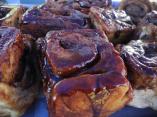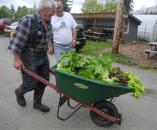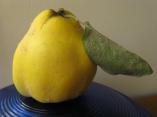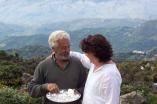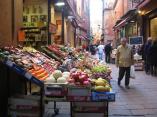We said a fond farewell to Peter Schollier on Wednesday, after an entertaining journey through Belgian cuisine and the poles of food neophilia and neophobia.
Belgian cuisine, which for most of us (who might think of it) means moules et frites, or Belgian waffles, or perhaps even waterzooi, has been subjected to scrutiny and refinement by modern Belgians and is now a large and growing and diverse – and as we might expect, somewhat regional – gastroterritory. Which is what you get from a country that only achieved independence in 1839, after centuries of wandering borders and serial occupation by and influence from the big guys on every side. Anyway, the only Belgian restaurant I know of outside Belgium is Belgo in London (its founders were a Belgian and a Canadian!); Schollier says that the incomparable Leon’s now has branches in Paris.
He then stepped carefully through the history of post-WW2 dining habits in Germany and Italy, building a case to compare the relative adventurousness of the Germans with the nationalistic, if not regionalistic preferences of the Italians. It was a story we’ve certainly seen played out ourselves in Italian restaurants and markets: no foreign dishes or products besmirch the menus of local eateries, and it is fiendishly difficult to find ‘foreign’ ingredients in traditional food retailers, including the open air markets. Which makes sense in many ways; it is absolutely consistent with the vision of Slow Food, for example, which advocates the preservation of local cuisines. But a tough course to follow with today’s international appetites: even in Italy the workforce is swimming with foreign labour which will surely have some kind of effect down the line.
I was curious about the kitchen garden (potager in French) class as I remembered the term from living in England. In Canada I think we exclusively used the more prosaic term ‘vegetable garden’. Which to the niggler doesn’t completely describe something that typically includes fruits and herbs.
Antoine Jacobsohn, from Le Potager du Roi, Versailles, is a specialist in the history of food and horticulture and he shared a bit of his ethnographic research into gardeners and gardening.
In one sesson, he gave us what must be a preview of the paper called “Hot Bed Techniques and Morals: Out of Season Produce in Early Modern France” which he’ll be delivering at a conference in Glasgow March 15-17 (Gardening: Histories of Horticultural Practice). He told us about hot beds which were used by Parisian market gardeners (and others, but Paris was our focus) to force vegetables out of season, with the aid of bell jars (aka cloches) and frames. Pretty much the same tricks used by home and allotment gardeners today. The morality discussion about out of season produce – is it right to trick nature into producing greater yield which, by nature, is less flavourful than seasonal produce? – is, he argued, not a contemporary one, but actually started sometime around 1600.
We learned that, for Parisians, the split between production and consumption only really happened in the 1960s when Les Halles, the vast central market, as well as the city’s slaughterhouse (from where the science museum, La Cité des Sciences et de l’Industrie now sits) were moved out of town. A good idea in many ways – traffic congestion and hygiene among them – but it did remove food’s origins from the lives and sight of the population who were buying it. The central market used to be a popular meeting and social place outside market hours (which were few as they only traded for four hours in the early morning). The new market at Rungis is ringed by roads suitable for road transport and is not particularly open to visitors, although a determined punter can get there by bus and perhaps manage to pay an entry toll for a look round.
He concluded with an overview of his oral history project, discussing with food producers around Paris their views on the food products of today. He surprised most of us, I think, by reporting that the people he spoke to are by and large pleased and proud of the food they produce, and consider it better in many ways than what was grown in the past, in terms of hygiene, cultivation methods, nutritional value and yield. They did not always evaluate it in terms of flavour, but those who did were able to state that what had tasted best in the past was also the trickiest to sell in high volume. Quality is a perishable commodity, and that’s what makes it hard to produce, difficult to distribute, and of course expensive to buy.




